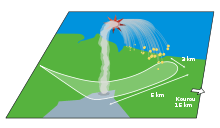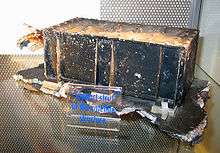Cluster (spacecraft)
| Mission type | Magnetospheric |
|---|---|
| Operator | ESA |
| Spacecraft properties | |
| Launch mass | 1,200 kilograms (2,600 lb) |
| Start of mission | |
| Launch date | 12:34:06, June 4, 1996 |
| Rocket | Ariane 5G |
| Launch site | Kourou ELA-3 |
| End of mission | |
| Disposal | launch failure |
| Destroyed | June 4, 1996 |
| Orbital parameters | |
| Reference system | Geocentric |
| Regime | Highly elliptical |
| Epoch | planned |
Cluster was a constellation of four European Space Agency spacecraft which were launched on the maiden flight of the Ariane 5 rocket, Flight 501, and subsequently lost when that rocket failed to achieve orbit. The launch, which took place on Tuesday, 4 June 1996, ended in failure due to an error in the software design caused by assertions having been turned off, which in turn caused inadequate protection from integer overflow. This resulted in the rocket veering off its flight path 37 seconds after launch, beginning to disintegrate under high aerodynamic forces, and finally self-destructing by its automated flight termination system. The failure has become known as one of the most infamous and expensive software bugs in history.[1] The failure resulted in a loss of more than US$370 million.[2]
Spacecraft
Cluster consisted of four 1,200 kilograms (2,600 lb) cylindrical, spin-stabilised spacecraft, powered by 224 watt solar cells. The spacecraft were to have flown in a tetrahedral formation, and were intended to conduct research into the Earth's magnetosphere. The satellites would have been placed into highly elliptical orbits; 17,200 by 120,600 kilometres (10,700 by 74,900 mi), inclined at 90 degrees to the equator.[3]
Launch failure


The Ariane 5 reused the inertial reference platform from the Ariane 4, but the Ariane 5's flight path differed considerably from the previous models. Specifically, the Ariane 5's greater horizontal acceleration caused the computers in both the back-up and primary platforms to crash and emit diagnostic data misinterpreted by the autopilot as spurious position and velocity data. Pre-flight tests had never been performed on the inertial platform under simulated Ariane 5 flight conditions so the error was not discovered before launch. During the investigation, a simulated Ariane 5 flight was conducted on another inertial platform. It failed in exactly the same way as the actual flight units.
The greater horizontal acceleration caused a data conversion from a 64-bit floating point number to a 16-bit signed integer value to overflow and cause a hardware exception. Efficiency considerations had omitted range checks for this particular variable, though conversions of other variables in the code were protected. The exception halted the reference platforms, resulting in the destruction of the flight.

Although a software error was identified as the direct cause, this was considered to be made possible by system design failures and management issues:[4][5]
- On the basis of those calculations the main computer commanded the booster nozzles, and somewhat later the main engine nozzle also, to make a large correction for an attitude deviation that had not occurred.
- A rapid change of attitude occurred, which caused the launcher to disintegrate at 39 seconds after H0 due to aerodynamic forces.
- Ariane 5's inertial reference system is essentially the same as a system presently flying on Ariane 4. The part of the software that caused the interruption in the inertial system computers is used before launch to align the inertial reference system and, in Ariane 4, also to enable a rapid realignment of the system in case of a late hold in the countdown. This realignment function, which does not serve any purpose on Ariane 5, was nevertheless retained for commonality reasons and allowed, as in Ariane 4, to operate for approximately 40 seconds from lift-off.
- During design of the software of the inertial reference system used for Ariane 4 and Ariane 5, a decision was taken that it was not necessary to protect the inertial system computer from being made inoperative by an excessive value of the variable related to the horizontal velocity, a protection provided for several other variables of the alignment software. When taking this design decision, it was not analysed or fully understood which values this particular variable might assume when the alignment software was allowed to operate after lift-off.
- In Ariane 4 flights using the same type of inertial reference system there had been no such failure because the trajectory during the first 40 seconds of flight is such that the particular variable related to horizontal velocity cannot reach, with an adequate operational margin, a value beyond the limit present in the software.
- Ariane 5 has a high initial acceleration and trajectory, which leads to a build-up of horizontal velocity five times more rapid than for Ariane 4. The higher horizontal velocity of Ariane 5 generated, within the 40-second timeframe, the excessive value that caused the inertial system computers to cease operation.
- The purpose of the review process, which involves all major partners in the Ariane 5 programme, is to validate design decisions and to obtain flight qualification. In this process, the limitations of the alignment software were not fully analysed and the possible implications of allowing it to continue to function during flight were not realised.
- The specification of the inertial reference system and the tests performed at equipment level did not specifically include the Ariane 5 trajectory data. Consequently, the realignment function was not tested under simulated Ariane 5 flight conditions, and the design error was not discovered.
- It would have been technically feasible to include almost the entire inertial reference system in the overall system simulations which were performed. For a number of reasons it was decided to use the simulated output of the inertial reference system, not the system itself or its detailed simulation. Had the system been included, the failure could have been detected.
- Post-flight simulations have been carried out on a computer with software of the inertial reference system and with a simulated environment, including the actual trajectory data from the Ariane 501 flight. These simulations have faithfully reproduced the chain of events leading to the failure of the inertial reference systems.
Aftermath
Following the failure, four replacement Cluster II satellites were built. These were launched in pairs aboard Soyuz-U/Fregat rockets in 2000.
The launch failure brought the high risks associated with complex computing systems to the attention of the general public, politicians, and executives, resulting in increased support for research on ensuring the reliability of safety-critical systems. The subsequent automated analysis of the Ariane code (written in Ada) was the first example of large-scale static code analysis by abstract interpretation.[6]
The failure also harmed the excellent success record of the European Space Agency's rocket family, set by the high success rate of the Ariane 4 model. It was not until 2007 that Ariane 5 launches were recognised as being as reliable as those of the predecessor model.[7]
See also
- Mars Climate Orbiter software that had been adapted from an earlier Mars Climate Orbiter was not adequately tested before launch
- Apollo guidance computer – PGNCS trouble, another case where a spacecraft guidance computer suffered from having a subsystem inappropriately left running
References
- ↑ Gleick, James (1 December 1996). "A Bug and A Crash". New York Times Magazine. Retrieved 7 April 2012.
- ↑ Dowson, M. (March 1997). "The Ariane 5 Software Failure". Software Engineering Notes. 22 (2): 84. doi:10.1145/251880.251992.
- ↑ Krebs, Gunter. "Cluster 1, 2, 3, 4, 5, 6, 7, 8". Gunter's Space Page. Retrieved 29 November 2011.
- ↑ Nuseibeh, Bashar (May 1997). "Ariane 5: Who Dunnit?" (PDF). IEEE Software. 14 (3): 15–16. doi:10.1109/MS.1997.589224.
- ↑ Le Lann, Gérard (March 1997). "An Analysis of the Ariane 5 Flight 501 Failure – A System Engineering Perspective". Proceedings of the 1997 international conference on Engineering of computer-based systems (ECBS'97). IEEE Computer Society. pp. 339–346. ISBN 0-8186-7889-5.
- ↑ Faure, Christèle. "PolySpace Technologies History". Retrieved 3 October 2010.
- ↑ Todd, David (March 2007). ASCEND Space Intelligence News. Missing or empty
|title=(help)
Thomas, L.D. (2007) Selected Systems Engineering Process Deficiencies and their Consequences. Acta Astronautica, 61, 406–415.
External links
- Jacques-Louis Lions et al., Ariane 501 Inquiry Board report (html version at the Wayback Machine (archived 15 August 2000))
- Spaceflight Now – Cluster II – Ariane 501 explodes at the Wayback Machine (archived 25 March 2015), direct link to video file — Footage of the final seconds of the rocket flight.
- Wired – History's Worst Software Bugs — An article about the top 10 software bugs. The Ariane 5 Flight 501 software glitch is mentioned as one of these bugs.
- (German) Ariane 5 – 501 (1–3) — A good article (in German) where the actual code in question is given.
